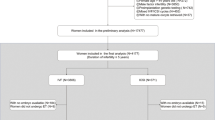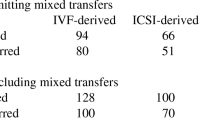Abstract
Purpose
To analyze cumulative and single-cycle success rates of IVF and intracytoplasmic sperm injection (ICSI) separately in relation to female age, fertilization modality, and first-cycle outcome.
Methods
The study involved 2997 patients and couples, respectively, who underwent 5339 fresh and 3006 cryo cycles using pronuclear-stage oocytes. Fertilization was achieved by the conventional IVF or ICSI. Because of legal restrictions in Germany, no embryo selection was performed. All cycles were documented prospectively. Kaplan–Meier survival rates were calculated for all treatment cycles and transferred embryos.
Results
Essentially, the success of assisted reproductive technology (ART) depends on a woman’s age and on skilful counselling. Cumulative pregnancy and live-birth rates are the best indicators of successful ART. Probably for the first time, we determined these cumulative rates separately for IVF and ICSI, and found them to be almost identical. Live-birth rates reached 70–95 %, except for women aged over 40 years, whose chances of life birth are limited to about 25 %. Live-birth rate per retrieval was 25.61 % for IVF and 26.3 % for ICSI. Time to pregnancy was shorter for women who underwent a successful treatment in their first cycle.
Conclusions
The primary intention for the choice of fertilization modality between IVF and ICSI is the prevention of a relative or total fertilization failure. Such treatment failure is best prevented through ICSI, which results in slightly higher clinical pregnancy rates per started cycle. After embryo transfer, there are no differences in the success rates of IVF and ICSI. The supposed cumulative live-birth rates are useful as a basis for counselling subfertile couples to help reduce the high discontinuation rate, which is still the main reason for inefficacy in ART. Following an unsuccessful first treatment cycle, the prognosis remains positive, but until success is achieved, more treatment cycles are necessary.




Similar content being viewed by others
References
Arvis P, Lehert P, Guivarc’h-Levêque A (2012) Simple adaptations to the Templeton model for IVF outcome prediction make it current and clinically useful. Hum Reprod 27:2971–2978. doi:10.1093/humrep/des283
Bhattacharya S, Hamilton MP, Shaaban M et al (2001) Conventional in vitro fertilisation versus intracytoplasmic sperm injection for the treatment of non-male-factor infertility: a randomised controlled trial. Lancet 357:2075–2079
Boulet SL, Mehta A, Kissin DM et al (2015) Trends in use of and reproductive outcomes associated with intracytoplasmic sperm injection. JAMA 313:255–263. doi:10.1001/jama.2014.17985
Cai QF, Wan F, Huang R, Zhang HW (2011) Factors predicting the cumulative outcome of IVF/ICSI treatment: a multivariable analysis of 2450 patients. Hum Reprod 26:2532–2540. doi:10.1093/humrep/der228
Choi B, Bosch E, Lannon BM et al (2013) Personalized prediction of first-cycle in vitro fertilization success. Fertil Steril 99:1905–1911. doi:10.1016/j.fertnstert.2013.02.016
Choi B, Santo-Domingo K, Penzias AS et al (2013) Turning past IVF data into personalized prognostics through a validated, multi-center IVF prediction model. Fertil Steril 99:S10–S11. doi:10.1016/j.fertnstert.2013.01.021
Croucher CA, Lass A, Margara R, Winston RM (1998) Predictive value of the results of a first in vitro fertilization cycle on the outcome of subsequent cycles. Hum Reprod 13:403–408
Daya S (2005) Life table (survival) analysis to generate cumulative pregnancy rates in assisted reproduction: are we overestimating our success rates? Hum Reprod 20:1135–1143. doi:10.1093/humrep/deh889
DIR—Deutsches IVF-Register: http://www.deutsches-ivf-register.de. Accessed 20 Nov 2015
Evers H Highlight of July 2014. http://www.eshre.eu/Publications/Journals/Human-Reproduction/Past-highlights.aspx. Accessed 13 Aug 2015
Ferraretti AP, Goossens V, Kupka M et al (2013) Assisted reproductive technology in Europe, 2009: results generated from European registers by ESHRE. Hum Reprod 28:2318–2331. doi:10.1093/humrep/det278
Garrido N, Bellver J, Remohí J et al (2011) Cumulative live-birth rates per total number of embryos needed to reach newborn in consecutive in vitro fertilization (IVF) cycles: a new approach to measuring the likelihood of IVF success. Fertil Steril 96:40–46. doi:10.1016/j.fertnstert.2011.05.008
Gnoth C, Maxrath B, Skonieczny T et al (2011) Final ART success rates: a 10 years survey. Hum Reprod 26:2239–2246. doi:10.1093/humrep/der178
Gnoth C, van der Steeg JW, Godehardt E, Friol K, Tigges J, Hilland U (2012) Interpretation von Spermiogrammen bei unerfülltem Kinderwunsch. Frauenarzt 53(11):1028–1032
Homburg R, Meltcer S, Rabinson J et al (2009) Do stimulation characteristics of the first in vitro fertilization cycle predict pregnancy in women of 40 years old and over? Fertil Steril 91:1311–1313. doi:10.1016/j.fertnstert.2008.01.094
Johnson LNC, Sasson IE, Sammel MD, Dokras A (2013) Does intracytoplasmic sperm injection improve the fertilization rate and decrease the total fertilization failure rate in couples with well-defined unexplained infertility? A systematic review and meta-analysis. Fertil Steril 100:704–711. doi:10.1016/j.fertnstert.2013.04.038
Kamphuis EI, Bhattacharya S, van der Veen F et al (2014) Are we overusing IVF? BMJ 348:g252
Klinkert ER, Broekmans FJM, Looman CWN, Te Velde ER (2004) A poor response in the first in vitro fertilization cycle is not necessarily related to a poor prognosis in subsequent cycles. Fertil Steril 81:1247–1253. doi:10.1016/j.fertnstert.2003.10.030
Land JA, Courtar DA, Evers JL (1997) Patient dropout in an assisted reproductive technology program: implications for pregnancy rates. Fertil Steril 68:278–281
García Lozano JC, Borrero Delgado A, Lozano Arana MD et al (2013) Prognostic factors of a first cycle of IVF with respect to the result of second cycle of IVF in women with primary infertility and younger than 40 years study on 1187 women. Fertil Steril 100:S499. doi:10.1016/j.fertnstert.2013.07.371
Luke B, Brown MB, Wantman E et al (2013) Second try: who returns for additional assisted reproductive technology treatment and the effect of a prior assisted reproductive technology birth. Fertil Steril 100:1580–1584. doi:10.1016/j.fertnstert.2013.07.1993
Malizia BA, Hacker MR, Penzias AS (2009) Cumulative live-birth rates after in vitro fertilization. N Engl J Med 360:236–243. doi:10.1056/NEJMoa0803072
Malizia BA, Dodge LE, Penzias AS, Hacker MR (2013) The cumulative probability of liveborn multiples after in vitro fertilization: a cohort study of more than 10,000 women. Fertil Steril 99:393–399. doi:10.1016/j.fertnstert.2012.10.01820
Mansour R, Ishihara O, Adamson GD et al (2014) International Committee for Monitoring Assisted Reproductive Technologies world report: assisted reproductive technology 2006. Hum Reprod 29:1536–1551. doi:10.1093/humrep/deu084
Nargund G, Waterstone J, Bland J et al (2001) Cumulative conception and live birth rates in natural (unstimulated) IVF cycles. Hum Reprod 16:259–262
Olivius K, Friden B, Lundin K, Bergh C (2002) Cumulative probability of live birth after three in vitro fertilization/intracytoplasmic sperm injection cycles. Fertil Steril 77:505–510
Osmanagaoglu K, Tournaye H, Camus M et al (1999) Cumulative delivery rates after intracytoplasmic sperm injection: 5 year follow-up of 498 patients. Hum Reprod 14:2651–2655
Soullier N, Bouyer J, Pouly JL et al (2008) Estimating the success of an in vitro fertilization programme using multiple imputation. Hum Reprod 23:187–192. doi:10.1093/humrep/dem352
Stern JE, Brown MB, Luke B et al (2010) Calculating cumulative live-birth rates from linked cycles of assisted reproductive technology (ART): data from the Massachusetts SART CORS. Fertil Steril 94:1334–1340. doi:10.1016/j.fertnstert.2009.05.052
Stolwijk AM, Wetzels AM, Braat DD (2000) Cumulative probability of achieving an ongoing pregnancy after in vitro fertilization and intracytoplasmic sperm injection according to a woman’s age, subfertility diagnosis and primary or secondary subfertility. Hum Reprod 15:203–209
Stovall DW, Matt DW, Steingold KA et al (2000) Predictors of IVF outcome in successful second IVF cycles following an unsuccessful first cycle. Fertil Steril 74:S226. doi:10.1016/S0015-0282(00)01389-3
Verhagen TEM, Dumoulin JCM, Evers JLH, Land JA (2008) What is the most accurate estimate of pregnancy rates in IVF dropouts? Hum Reprod 23:1793–1799. doi:10.1093/humrep/den209
Witsenburg C, Dieben S, Van der Westerlaken L et al (2005) Cumulative live birth rates in cohorts of patients treated with in vitro fertilization or intracytoplasmic sperm injection. Fertil Steril 84:99–107. doi:10.1016/j.fertnstert.2005.02.013
Wu B, Shi J, Lu S et al (2013) Understanding repeatability of human IVF traits to help physician embryologist predict next IVF cycle outcome. Fertil Steril 100:S499. doi:10.1016/j.fertnstert.2013.07.372
Author information
Authors and Affiliations
Corresponding author
Ethics declarations
Conflict of interest
All authors have nothing to declare have full control of all the primary data and agree to allow the journal review if requested.
Study funding
There was no study funding.
The study was conducted in accordance with the 1964 Helsinki declaration and all individual patients signed informed consent for data transfer and analysis.
Rights and permissions
About this article
Cite this article
Tigges, J., Godehardt, E., Soepenberg, T. et al. Determinants of cumulative ART live-birth rates in a single-center study: age, fertilization modality, and first-cycle outcome. Arch Gynecol Obstet 294, 1081–1089 (2016). https://doi.org/10.1007/s00404-016-4162-2
Received:
Accepted:
Published:
Issue Date:
DOI: https://doi.org/10.1007/s00404-016-4162-2




